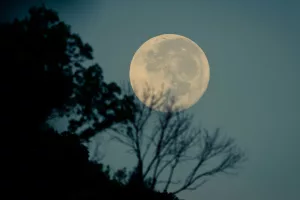The phases of the moon are a captivating celestial dance that has intrigued humans for centuries. These phases, from the full moon to the new moon and everything in between, are caused by the interplay between the sun, the moon, and the Earth. One key factor influencing the phases of the moon is the position of the moon in its orbit around Earth. The Role of Sunlight As the moon orbits Earth, the amount of sunlight falling on its surface changes, leading to the different phases we observe. For instance, during a full moon, the moon is directly opposite the sun, with its entire sunlit side facing Earth. This alignment results in the moon appearing as a fully illuminated circle in the night sky. In contrast, during a new moon, the side of the moon facing Earth is entirely in shadow, making it virtually invisible to observers on Earth.
Understanding the Moon’s Orbit
The moon’s orbit around Earth is not a perfect circle but rather an elliptical shape. This elliptical orbit means that the distance between the Earth and the moon changes slightly throughout the month. When the moon is closest to the Earth (perigee), it can appear up to 14% larger and 30% brighter than when it is farthest (apogee). These variations can subtly influence how we perceive the different phases of the moon.
The Impact of Elliptical Orbit
The elliptical nature of the moon’s orbit also affects the timing of the moonrise and moonset. For instance, a full moon near perigee—often referred to as a “supermoon”—can rise earlier and set later than when it is at apogee. This phenomenon not only affects the visual size of the moon but also how long we can observe it in the sky.
Tilt and Orbit of Earth
The tilt of Earth’s axis and the moon’s orbit around our planet also play crucial roles in determining moon phases. Earth’s axial tilt causes the moon to appear at varying angles in the sky relative to the sun, influencing the amount of sunlight that reaches its surface. This varying angle of illumination contributes to the distinct phases of the moon that we witness from Earth.
Ecliptic Plane and Moon’s Orbit
The moon’s orbit is inclined about 5 degrees to the ecliptic plane, which is the path the sun follows through the sky. This inclination means that the moon doesn’t always pass directly between the Earth and the sun, which is why we don’t experience a solar eclipse with every new moon or a lunar eclipse with every full moon.
Visible Changes
From waxing crescents to waning gibbous moons, the changing appearance of the moon is a result of its orbital position concerning the sun. During the waxing phases, where the illuminated portion of the moon is increasing, we observe a progression from a thin crescent to a half moon and eventually to a nearly full moon. Conversely, during the waning phases, the illuminated portion decreases, leading to a gradual decrease in the moon’s visible size until it reaches a new moon phase.
Waxing and Waning Phases Explained
The transition from new moon to full moon is called the “waxing” phase. During this time, the visible portion of the moon increases. After the full moon, the moon enters the “waning” phase, where the visible portion decreases. This cycle repeats approximately every 29.5 days, known as a lunar month.
Common Misconceptions
Many people mistakenly believe that the phases of the moon are caused by Earth’s shadow falling on the moon. This is a common misconception. In reality, the phases of the moon are due to its position relative to Earth and the sun. Earth’s shadow only plays a role during lunar eclipses.
Lunar Eclipses vs. Moon Phases
Lunar eclipses occur only during a full moon when the Earth is directly between the sun and the moon, casting a shadow on the moon. This is distinct from the regular phases of the moon, which are caused by the moon’s orbit around Earth and its changing position relative to the sun.
Observing the Moon Phases
Observing the moon’s phases can be a rewarding experience. With just a few tools and some patience, anyone can become a moon observer.
Tools for Observation
- Naked Eye: You don’t need any special equipment to observe the moon phases. Just look up at the night sky.
- Binoculars: These can enhance the view, allowing you to see more details on the moon’s surface.
- Telescope: For more serious observers, a telescope can reveal craters, mountains, and other features.
Keeping a Moon Journal
One practical tip for those interested in lunar observation is to keep a moon journal. Note the date, time, and appearance of the moon each night. Over time, you’ll notice the predictable pattern of the lunar cycle.
Cultural and Historical Significance
Throughout history, the phases of the moon have held significant cultural and practical importance.
Calendars and Timekeeping
Many ancient cultures used lunar calendars to track time. These calendars were based on the cycles of the moon rather than the sun. For example, the Islamic calendar is still lunar-based, which is why Islamic holidays shift annually in relation to the Gregorian calendar.
Moon Phases in Folklore
The moon has also played a role in folklore and mythology. From werewolves to harvest rituals, the phases of the moon have inspired countless stories and traditions.
Scientific Studies and the Moon
The scientific study of the moon and its phases has led to numerous discoveries about our closest celestial neighbor.
The Apollo Missions
The Apollo missions of the 1960s and 70s provided groundbreaking insights into the moon’s composition, geology, and history. These missions were crucial in enhancing our understanding of the moon beyond just its phases.
Modern Lunar Exploration
Today, space agencies continue to study the moon. Understanding its phases and cycles is essential for planning missions and lunar exploration.
The Moon’s Influence on Earth
The moon’s phases have more than just visual appeal; they also have tangible effects on Earth.
Tides and the Moon
The gravitational pull of the moon is the primary driver of ocean tides. During the full and new moon phases, the sun, moon, and Earth align, causing higher-than-normal tides known as spring tides.
Biological Rhythms
Many species, from corals to sea turtles, rely on the moon’s phases for biological rhythms and reproductive cycles. Understanding these natural patterns can help in conservation efforts.
Personal Insights and Experiences
As someone who has spent countless nights observing the moon, there’s a unique peace and rhythm to this practice. Watching the moon change night after night can be grounding, connecting us to natural cycles often overlooked in our busy lives.
How to Avoid Common Mistakes
When observing the moon, it’s easy to make a few common mistakes:
- Ignoring the Weather: Cloudy nights can obscure the moon, so check the weather forecast.
- Not Knowing the Lunar Calendar: Familiarize yourself with the lunar calendar to know when specific phases will occur.
- Overlooking Light Pollution: Try to observe the moon from a location with minimal artificial light for the best view.
Conclusion
The intricate interplay between these celestial bodies creates the mesmerizing spectacle of the moon’s phases, a phenomenon that continues to captivate astronomers and sky watchers alike. By understanding the science behind the moon’s phases, we can better appreciate the beauty and complexity of our universe. Whether you’re an amateur astronomer or just someone who enjoys looking up at the night sky, the phases of the moon offer a constant reminder of the ever-changing nature of the cosmos.



